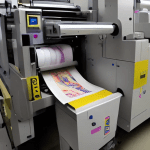In an era where sustainability and corporate responsibility have taken centre stage, Environmental, Social, and Governance (ESG) criteria have become a crucial benchmark for businesses across all sectors. ESG criteria offer a lens through which investors, consumers, and other stakeholders can assess the ethical impact and sustainability of a company. Among various industries, the printing business is undergoing a significant transformation, driven by the imperatives of ESG. This article explores the concept of ESG, its relation to the printing industry, and how flexo printing emerges as a beneficial approach in aligning with ESG criteria.
What is ESG?
Recently, the EU parliament has adopted mandatory sustainability reporting for all companies of a specific size by the beginning of 2024 with the long-term goal of having all companies report their impact in the future. The new regulation coming into effect is called the Corporate Sustainability Reporting Directive (CSRD). It will expand current rules by addressing more companies, approximately 50.000, and requiring more specific reporting from them.
ESG stands for Environmental, Social, and Governance, three key factors used to evaluate the sustainability and ethical impact of a company or business. Firstly, the environmental component concerns a company’s performance as a steward of nature, including how it manages its waste, resource utilisation, and its impact on climate change. Then, the social criterion examines how a company manages relationships with employees, suppliers, customers, and communities. Lastly, governance involves leadership, audits, internal controls, and shareholder rights. Together, these criteria help in determining the long-term viability and ethical footprint of a business.
Impact of ESG on the Printing Business
The printing industry, traditionally viewed as resource-intensive and polluting, faces increasing pressure to evolve in light of ESG criteria. With concerns over deforestation, energy consumption, water usage, chemical disposal, and carbon emissions, printing businesses are urgently re-evaluating their operations, supply chains, and product life cycles. Social and governance aspects also play a vital role, as companies must ensure fair labour practices, health and safety standards, and transparent corporate governance to meet the rising ESG expectations of stakeholders.
Benefits of Flexo Printing in Terms of ESG
Flexography, a modern printing technique known for its efficiency and versatility, stands out as particularly conducive to ESG goals within the printing industry. Below are key aspects in which flexo printing aligns with and benefits ESG criteria:
Environmental Benefits
Flexo printing has several features that make it an environmentally friendly option. It utilises water-based and UV-cured inks, significantly reducing the emission of volatile organic compounds (VOCs), which are harmful to both human health and the environment. Additionally, flexo presses can print on a wide variety of substrates, including recycled materials and biodegradable films, further supporting sustainability goals. The process also boasts high printing efficiency and low waste production, optimising resource use and minimising environmental impact.
Social Benefits
As flexo printing requires fewer chemicals and produces less waste compared to traditional printing methods, it contributes to a safer and healthier workplace. The reduction in hazardous substances and waste improves working conditions, aligning with the social component of ESG by prioritising employee wellbeing. Furthermore, the ability to use sustainable and recycled materials can help printing companies build a positive image and foster stronger relationships with eco-conscious consumers and communities.
Governance Benefits
Adopting flexo printing can also reflect positively on a company’s governance. By proactively addressing environmental concerns and championing sustainable practices, companies demonstrate accountability, forward-thinking leadership, and commitment to continuous improvement. These qualities can enhance corporate reputation, support compliance with regulations, and potentially attract investors looking for ethically sound and sustainable business models.
Towards a Sustainable Future
The transition towards more sustainable printing practices, guided by ESG criteria, is not merely a trend but a necessary shift to safeguard environmental and social resources for future generations. Flexo printing offers a pragmatic solution for printing businesses aiming to reconcile economic performance with environmental and social responsibility. Its adaptability to sustainable materials, efficiency in production, and reduced chemical use place flexo printing at the forefront of the printing industry’s journey towards sustainability.
Conclusion
The relevance of ESG to the printing business cannot be overstated, as it reshapes the industry’s trajectory towards sustainability and ethical practices. Flexo printing emerges as a compelling choice in this context, offering tangible benefits across environmental, social, and governance dimensions. By embracing flexo printing, companies can not only mitigate their ecological footprint but also foster social goodwill and adhere to robust governance practices, thereby securing a competitive edge in an increasingly conscientious market.
As the printing industry continues to evolve, it is clear that ESG considerations and sustainable printing methods like flexography will play a pivotal role in shaping its future. Through continuous innovation and commitment to ESG principles, the printing business can look forward to a more sustainable and responsible path forward.





